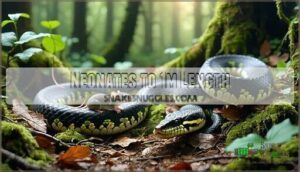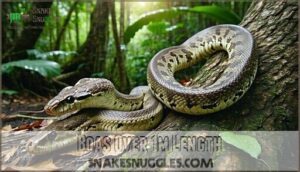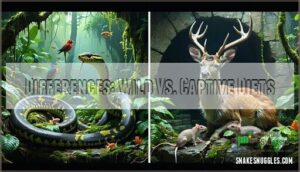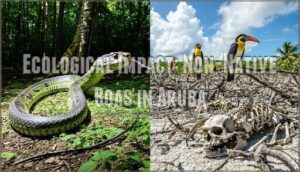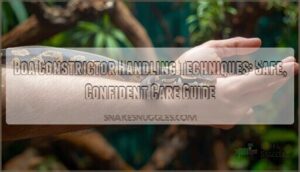This site is supported by our readers. We may earn a commission, at no cost to you, if you purchase through links.

Young boas start with tiny prey like lizards and baby mice, while adults can tackle rabbits and birds the size of chickens.
These carnivorous constrictors are opportunistic hunters that’ll grab whatever fits their current capabilities.
In captivity, you’ll typically feed them pre-killed rodents – mice for juveniles, rats for adults.
Wild boas have much more diverse diets, including frogs, birds, and even small primates.
Feeding frequency changes too: babies eat weekly, while mature boas can go months between meals.
Understanding their natural hunting patterns reveals some surprising dietary secrets.
Table Of Contents
- Key Takeaways
- Boa Constrictor Diet Composition
- Dietary Shifts With Growth
- Feeding Frequency and Prey Preferences
- Differences: Wild Vs. Captive Diets
- Ecological Impact: Non-Native Boas in Aruba
- Frequently Asked Questions (FAQs)
- What does a boa constrictor eat?
- How often do I feed my boa?
- What is the best food for boas?
- Do boas need live food?
- How often should I feed my pet boa constrictor?
- Can boa constrictors eat vegetables or fruits?
- What size prey is appropriate for my boa?
- Are there any foods toxic to boa constrictors?
- How long can a boa go without eating?
- Can boa constrictors eat frozen prey safely?
- Conclusion
Key Takeaways
- You’ll need to adjust prey size dramatically as your boa grows – start with pinky mice for babies and progress to rats or even rabbits for adults, with prey matching your snake’s thickest body section.
- Your feeding schedule changes significantly with age – juveniles eat weekly while mature boas can go 2-4 weeks between meals, reflecting their natural slow metabolism and hunting patterns.
- You should stick to pre-killed frozen rodents in captivity rather than live prey, as it’s safer and eliminates injury risks while providing the same nutritional benefits your snake needs.
- You can’t replicate the wild diet’s diversity in captivity, so consider supplementation needs since captive boas miss out on the natural variety of birds, lizards, and mammals they’d hunt in nature.
Boa Constrictor Diet Composition
Versatility defines the boa constrictor diet in wild settings.
You’ll discover these serpents are opportunistic hunters, with studies showing their meals consist of 40.4% birds, 34.6% lizards, and 17.3% mammals.
These apex predators showcase nature’s perfect balance—40% birds, 35% lizards, 17% mammals in their wild hunting repertoire.
This diverse boa constrictor food selection guarantees maximal Prey Nutritional Value through varied rodents, birds, and reptiles.
Their gastric adaptations maximize Digestion Efficiency when consuming Whole Prey Benefits.
However, captive boas often require Vitamin Supplementation since commercial diets lack natural variety.
The ideal Protein-Fat Ratio comes from whole animals rather than processed alternatives.
This prey diversity isn’t just survival—it’s nutritional genius that keeps these constrictors thriving across different habitats.
Dietary Shifts With Growth
You’ll notice your boa’s appetite changes dramatically as it grows from a tiny hatchling to a powerful adult.
What starts as pinky mice every week transforms into massive prey like rabbits every month, matching your snake’s expanding size and strength, which is a key aspect of its development into a powerful adult.
Neonates to 1m Length
From birth to their first meter, baby boa constrictors are surprisingly picky eaters with specific needs. Hatchling feeding starts with tiny small prey like pinkie mice or fuzzy mice, though wild babies prefer small lizards and birds.
You’ll need to provide frequent meals every 5-7 days to fuel their rapid growth rate. The prey size matters more than you’d think. Your snake food should create just a slight lump in their belly—too big and they’ll struggle, too small and they won’t thrive.
Feeding boa constrictor babies requires patience since they’re still learning to hunt effectively. Supplementation needs become vital in captivity where boa constrictor diet lacks wild variety. Your boa snake food routine should mimic nature’s buffet.
As they approach that magical one-meter mark, you’ll notice their appetite shifting toward bigger meals. To maintain proper digestion and overall health, maintain a temperature gradient within their enclosure.
Boas Over 1m Length
Once your boa constrictor reaches over 1 meter, you’re entering the big leagues of snake food. These impressive serpents can now handle prey up to 40% of their body weight – that’s some serious eating power! Your boa constrictor diet shifts dramatically from small lizards to substantial mammals and birds.
As boas mature, their dietary needs evolve, mirroring the feeding frequency adjustments required for ideal health. Here’s what changes in your feeding boa constrictor routine:
- Prey Size should match your snake’s widest point, creating a visible but manageable bulge
- Feeding Schedule extends to every 2-4 weeks instead of weekly meals
- Rats, rabbits, and quail become primary food sources for proper boa constrictor care
- Long-Term Health depends on maintaining proper prey proportions
- Supplement Needs decrease as whole prey provides complete nutrition
Frozen-thawed prey remains your safest bet for consistent boa snake food. This dramatic dietary shift reflects their natural hunting evolution and substantially impacts their Habitat Impact as apex predators.
Feeding Frequency and Prey Preferences
Understanding your boa’s feeding frequency and prey preferences becomes the key to successful snake ownership.
Juvenile boas need meals every 7-14 days, while adults can wait 2-4 weeks between feedings.
Your snake’s feeding schedule depends on prey size – larger meals extend feeding intervals naturally.
Boa constrictor diet centers around small mammals like rats, mice, and rabbits.
They’ll also hunt birds and lizards when available.
Prey size should match your snake’s mid-body width for safe swallowing.
Natural behaviors show they’re opportunistic hunters who adapt their prey preferences based on what’s available.
Many owners look for boa feeding products to help maintain a consistent schedule.
- Dietary variety prevents nutritional deficiencies and keeps your boa healthy
- Supplementation needs may arise in captivity without diverse prey options
Differences: Wild Vs. Captive Diets
Strikingly, wild and captive boa constrictor diets couldn’t be more different. In nature, your snake would feast on an incredible Prey Diversity – from fish and lizards to birds and even small deer. This wild buffet provides natural Nutrient Variation that keeps boas healthy and strong.
Captive boas face a completely different reality. You’ll typically feed them frozen rodents like mice and rats, creating potential Supplement Needs since this limited menu can’t match nature’s complexity. Captive snakes often require attention to calcium and phosphorus to maintain strong bones.
| Wild Boas | Captive Boas |
|---|---|
| Hunt diverse prey species | Eat mainly rodents |
| Self-regulate feeding | Owner-controlled portions |
| Natural nutritional balance | Risk nutritional deficiencies |
The Obesity Risk increases dramatically in captivity due to overfeeding and lack of hunting exercise. Ethical Sourcing becomes your responsibility – choosing quality prey that meets your boa’s nutritional requirements. Understanding these differences helps you create the best possible diet plan for your captive snake, considering the importance of Natural Nutritional Balance and avoiding potential Nutritional Deficiencies.
Ecological Impact: Non-Native Boas in Aruba
How did a small Caribbean island become ground zero for one of nature’s most dramatic invasive species takeovers? Aruba’s boa impact tells a sobering story of ecosystem disruption in action.
These powerful constrictors arrived through the exotic pet trade in the 1980s and have since triggered ecological chaos across the island. The numbers are staggering – these invasive species kill over 17,000 native birds annually, creating massive ecosystem balance shifts.
Their remarkable prey diversity makes them ecological bulldozers, consuming everything from tiny lizards to medium-sized mammals. Current conservation challenges include:
- Rapidly expanding populations despite aggressive population control efforts
- Widespread habitat adaptation across diverse island environments
- Severe declines in native bird and reptile populations
- Disrupted predator-prey relationships affecting food webs
- Limited effectiveness of removal programs due to reproductive capacity
This ecological impact demonstrates how quickly invasive species can reshape entire ecosystems.
Frequently Asked Questions (FAQs)
What does a boa constrictor eat?
You’ll find these powerful serpents devouring birds, lizards, and mammals in the wild.
They’re opportunistic hunters who’ll tackle prey up to 40% of their body weight, from tiny mice to deer-sized animals.
How often do I feed my boa?
Feed your boa every 7-12 days when young, then every 2-4 weeks as adults. You’ll know it’s time when they’re actively hunting or their last meal has fully digested.
What is the best food for boas?
Like fuel for a high-performance engine, you’ll want pre-killed frozen rodents as your boa’s staple diet.
Rats and mice work best, with occasional rabbits or chicks adding variety for ideal nutrition and health.
Do boas need live food?
You don’t need to feed your boa live prey.
Pre-killed or frozen-thawed rodents work perfectly and are actually safer.
They eliminate injury risks from struggling prey while providing the same nutritional benefits your snake needs.
How often should I feed my pet boa constrictor?
Your boa’s feeding schedule depends on age and size.
Juveniles need meals every 7-10 days, while adults eat every 2-4 weeks.
You’ll master their rhythm by watching their body condition and growth rate.
Can boa constrictors eat vegetables or fruits?
Your scaly friend’s a strict carnivore who can’t stomach plant matter.
Don’t expect them to go green—vegetables and fruits will literally make them sick.
Stick to whole prey like rats and mice for ideal health.
What size prey is appropriate for my boa?
Your prey should match your snake’s thickest body section and create a slight belly bulge after feeding. Generally, that’s 10-15% of your boa’s body weight for ideal digestion and health.
Are there any foods toxic to boa constrictors?
Most foods aren’t toxic to your boa, but avoid feeding wild-caught prey that might carry parasites or diseases.
Stick to captive-bred, pre-killed rodents and birds.
Never feed chocolate, onions, or anything seasoned—your snake doesn’t need human snacks.
How long can a boa go without eating?
Your serpent can survive months without eating, thanks to their incredibly slow metabolism.
Adult boas routinely fast for 2-6 months, especially during breeding season or cooler temperatures, without any health concerns whatsoever, which is a testament to their ability to survive for extended periods without eating.
Can boa constrictors eat frozen prey safely?
Yes, you can safely feed your boa frozen-thawed prey.
It’s actually recommended over live feeding since it reduces injury risk and prevents disease transmission.
Just make certain you thaw it completely and warm it properly before offering, which is a crucial step to ensure the health and safety of your boa, involving complete thawing.
Conclusion
Like a master chef adapting recipes to their guests, you’ll need to tailor boa constrictor food to match your snake’s size and life stage.
You’ve learned that feeding frequency decreases as your boa grows, while prey size increases dramatically.
Whether you’re caring for a tiny neonate or a massive adult, understanding these natural dietary patterns guarantees your boa thrives.
Remember, proper feeding isn’t just about size—it’s about respecting their wild hunting instincts in captivity.
- https://nationalzoo.si.edu/animals/boa-constrictor
- https://reptifiles.com/boa-constrictor-care/what-do-boa-constrictors-eat
- https://www.petmd.com/reptile/boa-constrictor-care-sheet
- https://www.animalsathome.ca/boa-constrictor-feeding-chart
- https://www.reddit.com/r/snakes/comments/7m8blz/varied_diet_for_adult_boa

